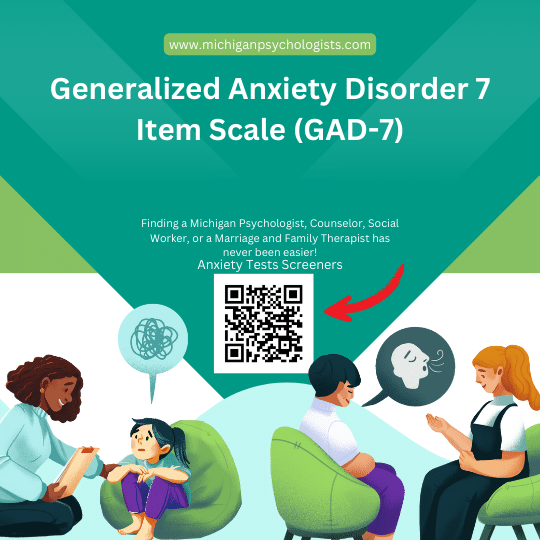Generalized Anxiety Disorder 7 Item Scale (GAD-7)
Home » Psychological Tests » Anxiety Tests Screeners » Generalized Anxiety Disorder 7 Item Scale (GAD-7)
Table of Contents
In the complex landscape of mental health, anxiety disorders stand out as some of the most common and debilitating conditions. Among these, Generalized Anxiety Disorder (GAD) is particularly prevalent, characterized by persistent and excessive worry about various aspects of life. Early and accurate identification of GAD is crucial for effective intervention and management. One of the most widely used tools for this purpose is the Generalized Anxiety Disorder 7 Item Scale (GAD-7). This article delves into the GAD-7, exploring its purpose, application, scoring, accuracy, and providing answers to frequently asked questions.
What is the Generalized Anxiety Disorder 7 Item Scale (GAD-7)?
The Generalized Anxiety Disorder 7 Item Scale (GAD-7) is a brief self-report questionnaire designed to screen for and measure the severity of generalized anxiety disorder. Developed by Drs. Robert L. Spitzer, Janet B.W. Williams, Kurt Kroenke, and colleagues, the GAD-7 is widely used in clinical settings to identify individuals who may need further assessment and to monitor the severity of their anxiety symptoms over time.
Purpose of the GAD-7
The primary purposes of the GAD-7 are to:
- Identify symptoms of generalized anxiety disorder in individuals.
- Measure the severity of anxiety symptoms.
- Monitor changes in anxiety levels over time to evaluate treatment effectiveness.
How the Generalized Anxiety Disorder 7 Item Scale (GAD-7) is Used
The GAD-7 consists of seven questions that assess the frequency of anxiety symptoms over the past two weeks. Each question corresponds to a specific symptom of GAD, such as feeling nervous, inability to stop worrying, and difficulty relaxing.
Steps to Administer the GAD-7:
- Self-Administration: The individual completes the questionnaire by indicating how often they have experienced each symptom in the past two weeks.
- Scoring: Each response is scored based on the frequency of symptoms.
- Interpretation: The total score is interpreted to determine the severity of anxiety.
How the Generalized Anxiety Disorder 7 Item Scale (GAD-7) is Scored
Each of the seven items on the GAD-7 is scored on a scale from 0 to 3:
- 0: Not at all
- 1: Several days
- 2: More than half the days
- 3: Nearly every day
The total score is calculated by summing the scores for each of the seven items, resulting in a score range of 0 to 21.
Scoring Guidelines:
- 0-4: Minimal anxiety
- 5-9: Mild anxiety
- 10-14: Moderate anxiety
- 15-21: Severe anxiety
A score of 10 or above is commonly used as the threshold for identifying cases of GAD that may require further evaluation and possible intervention.
The Accuracy of the Generalized Anxiety Disorder 7 Item Scale (GAD-7)
The GAD-7 has been extensively validated and is considered a reliable and valid tool for screening and assessing the severity of generalized anxiety disorder. Research has demonstrated its strong psychometric properties, including high sensitivity and specificity.
Key Points on Accuracy:
- Sensitivity: The GAD-7 effectively identifies individuals with GAD.
- Specificity: The GAD-7 accurately differentiates between those with and without GAD.
- Clinical Utility: The GAD-7 is useful for both initial screening and ongoing assessment of anxiety symptoms.
Frequently Asked Questions (FAQ)
1. What is the GAD-7 used for?
The GAD-7 is used to screen for generalized anxiety disorder and measure the severity of anxiety symptoms.
2. How long does it take to complete the GAD-7?
The GAD-7 typically takes about 2-5 minutes to complete.
3. Can the GAD-7 diagnose generalized anxiety disorder on its own?
No, the GAD-7 is a screening tool and should be followed by a comprehensive diagnostic assessment if needed.
4. What is the scoring threshold for further evaluation?
A score of 10 or above suggests the need for further evaluation by a healthcare professional.
5. Are there any limitations to the GAD-7?
While the GAD-7 is a valuable tool, it relies on self-reporting and may be influenced by an individual’s perception of their symptoms.
6. Can the GAD-7 be used for children and adolescents?
The GAD-7 is primarily designed for adults, but modified versions or other tools are more suitable for younger populations.
7. Is the GAD-7 available in multiple languages?
Yes, the GAD-7 has been translated and validated in numerous languages.
8. How often should the GAD-7 be administered?
The GAD-7 can be used periodically to monitor changes in anxiety symptoms, especially during treatment.
9. What should be done if the GAD-7 score indicates severe anxiety?
A high score on the GAD-7 should prompt further evaluation and discussion with a healthcare professional to explore treatment options.
10. Can the GAD-7 be used in conjunction with other screening tools?
Yes, the GAD-7 can be used alongside other screening tools to provide a comprehensive assessment of an individual’s mental health.
The Generalized Anxiety Disorder 7 Item Scale (GAD-7) is a vital tool in the early identification and management of generalized anxiety disorder. Its simplicity, reliability, and validity make it an essential component of mental health screening and assessment. By understanding how to use, score, and interpret the GAD-7, healthcare professionals and individuals can take proactive steps toward addressing anxiety and improving overall well-being.
